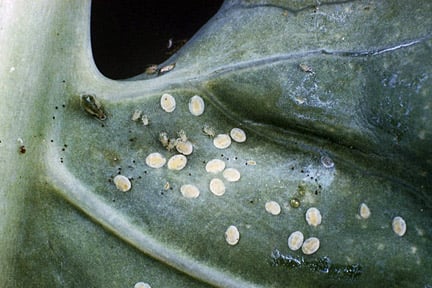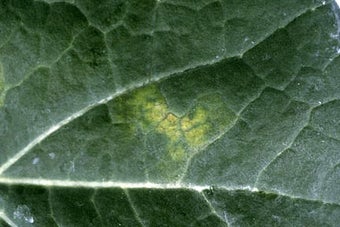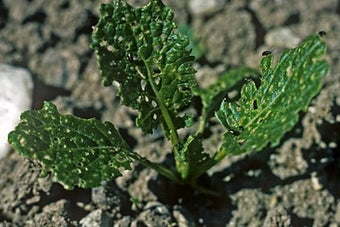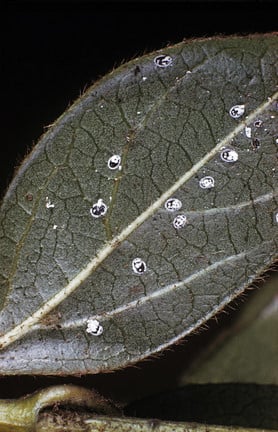
Quick facts
Common name - Cabbage whitefly
Scientific name - Aleyrodes proletella
Plants affected - All leafy brassicas, including kale cabbage, broccoli and Brussels sprout
Main symptoms - Small white winged and scale-like insects on the underside of leaves. Sooty moulds may develop on upper leaf surfaces
Most active - All year round
What is cabbage whitefly?
Whiteflies are sucking true bugs (Hemiptera) in the family Aleyrodidae. The adults are typically white and fly up from host plants. There are around eight species found in Britain, some are restricted to a limited host range others are found indoors on a wide range of plants.
Cabbage whitefly is only found on brassicas, normally on the outer leaves, where in gardens and allotments they can often be tolerated. It can however, be a problem on kale, as the insect can develop on the foliage that is destined for dinner plates.
Symptoms
- White-winged insects, 1.5 mm long, that fly up in clouds from the underside of brassica leaves when disturbed
- Flat, oval, whitish-green scale-like nymphs are attached to the lower leaf surface
- Black or greenish-grey can develop on the upper leaf surface on the sticky honeydew excreted by this insect
- Cabbage whitefly should not be confused with glasshouse whitefly or viburnum whitefly which are rarely found on brassicas
Management
Cabbage whitefly only affects outer leaves and usually causes little real damage to parts of the plant that are consumed, therefore populations can usually be tolerated. The damage is more significant with crops such as kale where young leaves are used. Cabbage whitefly can be difficult to control, particularly on allotments where there are likely to be affected plants on nearby plots that will be a source of re-colonisation.
- Tolerate the presence of cabbage whitefly, as it does not normally affect edible parts, apart from crops like kale where the young leaves are used
- Encourage predators and other natural enemies of whitefly, in the garden, such as ladybirds, wasps and ground beetles
- Encourage parasitoid wasp predators. Cabbage whitefly is nota host of the biological control, Encarsia formosa parasitoid sold for use against glasshouse whitefly (Trialeurodes vaporariorum) but there are some other Encarsia species that occur naturally in Britain that develop as larvae in cabbage whitefly nymphs. They are not commercially available but can be numerous and keep cabbage whitefly at a low level.
Biology
Cabbage whitefly is present on its host plants throughout the year and overwinters as adult insects.
- The adults lay eggs on the lower leaf surface, from which hatch the scale-like nymphs
- Both adults and nymphs suck and excrete a sugary substance (honeydew) that allows the growth of
- Brassicas are tolerant of this insect and it usually has little impact on plant growth, but sooty mould can be a problem, especially on sprout buttons and the leaves of kale
- Although similar in appearance to glasshouse whitefly, cabbage whitefly is a different species and does not feed on plants other than brassicas
- Similarly glasshouse whitefly will not feed on brassicas out of doors







